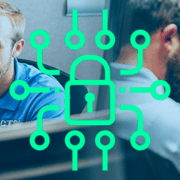The importance of investing in cybersecurity awareness training for government agencies
A cybersecurity awareness training program is a powerful way to educate government employees on the current cyber threat landscape in order to reduce the risk of cyberattacks and engrain a strong security culture within a government organization. Employee training is a continuous process covering several topics and practices, including:
- Basic cyber hygiene
- Social engineering threats
- Threat recognition and response
- Attack simulations
- Review of security guidelines and policies
- Personal responsibilities in corporate cybersecurity
The problem
Every organization’s first line of defense against cyber threats is their employees, but they’re also the weakest security link. According to a report from Verizon, 85 percent of all successful data breaches in 2020 involved the human element. Rigorous cybersecurity awareness training is the key to turning this human weakness into a strength.
However, many government agencies and offices don’t understand the importance of incorporating cybersecurity awareness training in their security framework. According to a survey conducted by TalentLMS, 69 percent of the respondents claimed to have received security training, yet 61 percent failed a basic cybersecurity quiz. Only 1% of employees answered all the quiz questions correctly, and most of those who failed said they felt safe from threats.
While most government organizations make an effort to educate employees on cybersecurity, they still fall short of the goal. Given the ever-changing threat landscape caused by the ongoing pandemic and the widespread remote working trend, it’s about time every government organization took cybersecurity awareness training seriously. Here are the four reasons to invest in cybersecurity awareness programs for state and local government employees to drive this point home.
Keep up with regular training as threats evolve
Awareness plays a huge part in the battle against cybercrime, mainly that threat actors are increasingly focusing on human vulnerabilities to arrange social engineering attacks. For example, phishing attack incidents skyrocketed in 2020 and show no indication of slowing down any time soon.
Breaches that have recently affected state and local governments
State and local government organizations are equally affected by cyberattacks, just like private sector businesses. Recent attacks have stalled daily operations for a significant amount of time and have involved both government offices and their citizens.
The government of an Illinois county
The government in St. Clair County, Illinois, was the victim of a cyberattack at the end of May that caused weeks-long disruptions, according to Government Technology. According to the report, the hack prevented residents from using online systems to access court records or pay taxes. A ransomware group named Grief took responsibility for the attack.
City of Tulsa’s computer systems
According to the Associated Press, hackers in May breached computer systems in the City of Tulsa, Oklahoma, prompting officials to shut them down quickly. City residents were left unable to use online systems to pay their water bills. A spokesperson for the city of Tulsa said the hack was stopped before any information could be leaked, according to the AP.
The changing work model
Securing remote workers is different from on-location, and there are more factors to consider. Government employees are now more vulnerable than ever, given that most of them are working from home while using their internet connection and devices.
Factors to take into consideration include:
- File access
- How often backups are conducted
- Data sharing capabilities
- How employees should get in contact with the IT team in case an issue arises
Achieve compliance
Regular cybersecurity awareness training is required in most data security regulations, frameworks, and standards, including HIPAA, GDPR, PCI DSS, and FISMA. To bring about and maintain compliance with these regulations, employees handling sensitive information must prove that they’ve undergone essential cybersecurity training.
Building a culture of security awareness
Cybersecurity training is not just meant for internal IT teams. It should bring all government departments and employees on board with common cybersecurity best practices. This helps create a strong culture that encourages everyone to make thoughtful decisions according to the agency’s security policies. Instilling a self-driven cybersecurity responsibility in each employee is the closest you can get to creating a human firewall.
Investing in cybersecurity awareness pays off
You can quickly calculate the economic value or ROI of cybersecurity awareness training by dividing the net benefits by costs. In doing so, the net benefits include the cost of data breaches, compliance fines, and business losses that could be avoided through awareness training. The costs figure sums up the total expenses incurred during training.
The potential financial implications of neglecting cybersecurity training far outweigh the cost of training. Remember that data breaches can have other incalculable consequences, such as downtime and lost trust.
As you invest in security tools, services, and software, don’t forget to designate enough resources in your IT budget to educate employees on cybersecurity awareness. It’s an easy and inexpensive way to close gaping security holes in your organization.
CTSI can help you get started with educating your staff on cybersecurity. We understand the staff’s role in a government agency’s security posture, which is why training is such a crucial part of our security package. Talk to us to learn more about how to strengthen your cybersecurity in your agency.
















